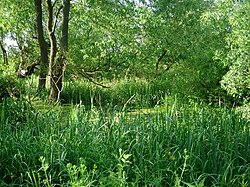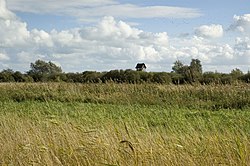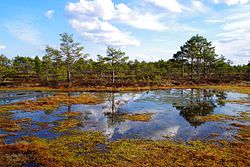Fen

A fen is a type of wetland. It is usually fed by mineral-rich surface water or groundwater.[1] Fens have neutral or alkaline water, with dissolved minerals but few other plant nutrients. They are usually dominated by grasses and sedges, and typically have brown mosses like Scorpidium or Drepanocladus.[2]p8
Fens may have a high diversity of other plant species, including carnivorous plants such as Pinguicula.[2]ch9[3] Fens may occur along large lakes and rivers where seasonal changes in water level keep soil wet, with few woody plants.[4]
The distribution of individual species of fen plants is connected to water regimes and nutrient concentrations.[5][6]
Fens have a characteristic set of plant species, which indicate environmental conditions. They are called "fen indicator species".[7]
Fens are distinguished from bogs. Bogs which are acidic, low in minerals, and usually dominated by sedges and shrubs, with abundant Sphagnum mosses.[2]p8
Fens have been damaged in the past by land drainage, and also by peat cutting.[8] Some are now being carefully restored with modern management methods.[2]ch13 The principal challenges are to restore natural water flow regimes, to keep the quality of water, and prevent invasion by woody plants.
Fen Media
Avaste Fen, Estonia. Sedges dominate the landscape, woody shrubs and trees are sparse.
Wicken Fen, England. Grasses in the foreground are typical of a fen.
Small extreme rich fen in southwestern Minnesota. The white flowers, Parnassia glauca, are a fen indicator species in Minnesota.
Dernford Fen, Cambridgeshire
Related pages
References
- ↑ Godwin K.S. et al 2002. Linking landscape properties to local hydrogeologic gradients and plant species occurrence in New York fens: a hydrogeologic setting (HGS) framework. Wetlands, 22, 722–37.
- ↑ 2.0 2.1 2.2 2.3 Keddy P.A. 2010. Wetland ecology: principles and conservation. 2nd ed, Cambridge University Press.
- ↑ Wheeler B.D. and Giller K.E. 1982. Species richness of herbaceous fen vegetation in Broadland, Norfolk in relation to the quantity of above-ground plant material. Journal of Ecology, 70, 179–200.
- ↑ Charlton D.L. & Hilts S. 1989. Quantitative evaluation of fen ecosystems on the Bruce Peninsula. In Ontario Wetlands: inertia or momentum? eds. M.J. Bardecki and N. Patterson, pp. 339–54. Proceedings of Conference, Ryerson Polytechnical Institute, Toronto, Oct 21–22, 1988. Toronto, ON: Federation of Ontario Naturalists.
- ↑ Slack N.G; Vitt D.H. & Horton D.G. 1980. Vegetation gradients of minerotrophically rich fens in western Alberta. Canadian Journal of Botany. 58, 330–50.
- ↑ Schroder H.K. et al 2005. Rejecting the mean: estimating the response of fen plant species to environmental factors by non-linear quantile regression. Journal of Vegetation Science, 16, 373–82.
- ↑ Godwin K.S. et al 2002. Linking landscape properties to local hydrogeologic gradients and plant species occurrence in New York fens: a hydrogeologic setting (HGS) framework. Wetlands, 22, 722–37. Table 3.
- ↑ Sheail J. & Wells T.C.E. 1983. The Fenlands of Huntingdonshire, England: a case study in catastrophic change. In Ecosystems of the World, vol. 4B Mires: Swamp, Bog, Fen and Moor – Regional Studies. ed. A.J.P. Gore, pp. 375–93. Amsterdam: Elsevier.








